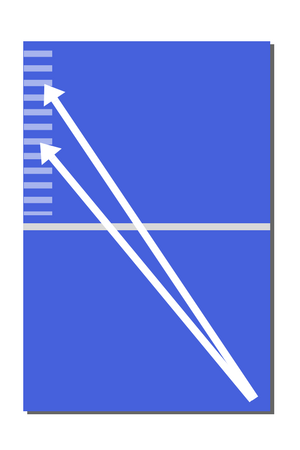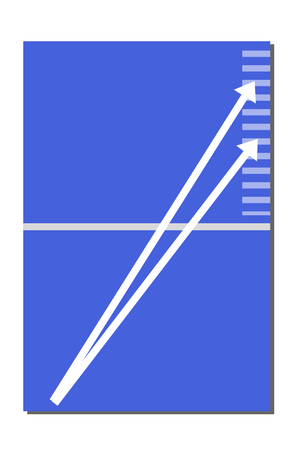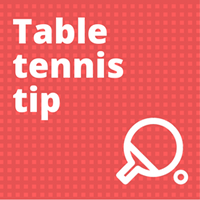I recently attended a training camp at Westfield Table Tennis Club and one of the other players started calling me ‘Mr Angles’. I quite liked this. He gave me this name as I kept playing shots wide to his forehand and backhand and he was having trouble getting to these shots.
This wasn’t something I was consciously doing to be mean. I’m just so used to playing angled shots. It’s something I do without thinking.
And of course, it can be very effective. It’s a great way of stretching your opponent, keeping him off-balance, and opening up the table so you can control the rally.
In this blog post, I explain what I mean by ‘angled shots’, why they are effective and how you can practice angled shots in your training sessions.
What are ‘angled shots’?
What do I mean by ‘angled shots’? These are shots which are aimed to the side of the table. The ball, if left alone, would continue its direction somewhere between the end of the table and the net, as shown in the diagrams below.


An angled shot could be any type of shot – push, block, flick, topspin etc – and fast or slow.
It’s often easier to play an angled shot if the ball is short on either the forehand or backhand side, but you can also play angled shots from behind the table too, especially if the ball is wide to the forehand or backhand.
Why are angled shots effective?
Angled shots are really good at stretching your opponent. If you use angles, your opponent has to cover a larger playing area. He has to work harder to stay in the rally.
If a player has poor footwork, he may not reach your angled shots at all, so it can be a very easy way to win points.
If a player has ‘ok’ footwork, you may force him to stretch for your angled shots. If a player is stretching for shots, he will be off-balance and it will be difficult for him to play good quality shots. So you often get a weak ball back, which you can attack with your next shot.
Even if a player has good footwork and can get to your angled shots, you will have succeeded in moving the player off the table, which gives you more space to aim your next shot.
The most basic tactic is to send a player wide and then aim your next shot to the opposite side of the table. You move the player left and right, chasing down balls. Your opponent does all the hard work. You control the rally without breaking sweat.
How to get good at angled shots
To get good at angled shots requires lots of deliberate practise. To start with I recommend this really simply exercise…
Forehand to forehand, backhand to backhand
When players warm-up, they usually hit forehand to forehand to the middle of the forehand side and backhand to backhand to the middle of the backhand side.
Instead of playing to just one position (e.g. middle of forehand side), vary the placement of your shots. Hit some to the middle of the forehand side, some towards the middle of the table and some angled shots to the wide forehand. You can do the same for backhand to backhand too.
You can make a game of it. So if playing forehand to forehand, you are only allowed to play on the forehand side of the table, but you can play to any position on the forehand side of the table.
The object of the game is to beat each other with ball placement, rather than smashing the ball past each other. Play up to 7 points. If you can hit an outright winner playing an angled shot, then you get 2 points.
This simple variation of forehand to forehand or backhand to backhand rallies will give you the chance to practise both angled shots and your footwork to reach your partner’s angled shots.
Final thoughts
Any player, at any standard, can play angled shots.
We had a player in the Cambridge league, who must have been 80-years-old. He wasn’t able to move very well, but he was able to compete with, and beat, much younger players but using a lot of angled shots. He would stretch them wide to the forehand and wide to the backhand, forcing his opponents to make mistakes or weak shots. It was so simple, but so effective.
Angled shots work for me too. Often, I don’t need a great deal of power when playing these shots. It’s the angles which cause all the problems. There is something very satisfying about sending an opponent wide, opening up the table and then guiding the ball to the opposite side of the table for a clean winner, as the player can’t get back quick enough.
If you don’t use angled shots at the moment, I encourage you to give it a go. Angled shots are a great addition to your stroke repertoire. You can use them to really stretch your opponent, keep them off-balance and make them look a bit silly.

